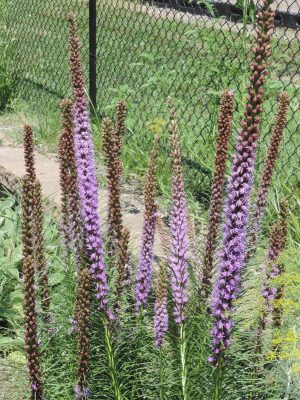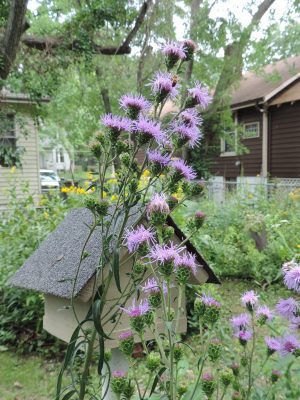By Kathy Bildner
Member, Wild Ones – St. Louis Chapter
I hope you have blazing stars (Liatris) flowering in your yard. They are a wonderful addition to the native flower landscape. There is a type of Liatris for dry or wet locations and sunny to partial shade, so everyone needs to have them in their yard. They are tall and slender and do not take up much space. Pollinators love them. The Monarch butterflies flock to them on their way back South.
Liatris grow from roundish corms (a swollen root similar to a bulb), each putting out one to several stems, two to four feet tall. Corms are a good base to keep stalks strong and straight. They store energy for the plant protecting it in times of drought and cold.
Liatris flower color is pink to purple, rarely white, displayed as a spike of flowers or alternating flowers at the top of the stem. The flowers open from the top down.
The leaves of Liatris alternate up the stem and are larger at the bottom and smaller towards the top.
If you do not remember which of our native Liatris you have in your yard, I hope this blog post helps.
According to Flora of Missouri, volume 2, (first published in 1963 by author Julian Steyermark and revised by George Yatskievych 2006), there are nine Liatris that are native to Missouri.
There are four types of Liatris that have a spike flower and five that have alternating flowers at the top of the stems. This helps to tell them apart from each other. Another defining characteristic is that the larger lower leaf of a Liatris either has one main vein or three to five veins.
I am going to describe the four most common Liatris I see in our yards.
Rough gay feather (Liatris aspera) and Eastern blazing star (Liatris scariosa) have one main vein in the large lower leaf. In both of these plants, the flowers present as alternating at the top of the stem.
Marsh blazing star (Liatris spicata) and prairie blazing star (Liatris pycnostachya) have three to five veins in their largest lower leaf. The flowers present evenly distributed as a spike at the top of the stem.
Once you know how many veins are in the lower leaves and how the flowers grow along the top of the stem, it is time to look at the bracts. The bracts are the part of the flower beneath the petals. They look like the vase holding the flower together.
Liatris aspera has bract edges that are pouched outward, are irregular, wavy, and purple tinged.
The other Liatris with alternating flowers, Liatris scariosa has bracts curved outward with scalloped margins, narrow and thin, also purple tinged.
Spiked flowering Liatris spicata’s bracts are flat with blunt tips. The other spiked flowering Liatris, Liatris pycnostachya, has bracts curved outward with sharp points.
A few other facts: Liatris spicata requires more moisture than other Liatris. Liatris pycnostachya is the tallest of all the Liatris. Liatris aspera leaves are a grayer green than L. scariosa. Liatris aspera needs a sunny and dry location to survive. Aspera means rough, hard, cruel and Liatris aspera is tough. In contrast Liatris scariosa, also hardy will tolerate some shade.
I hope this was helpful. Sometimes I get caught up in my own plant ID needs and forget others do not care the same way. I am obsessed with seeing plants in their natural habitat and noticing what plants grow in certain communities.






Kathy,
I’m grateful that you care about the little details of identification. In the big picture, it is wonderful to see so many species living alongside each other. We could all learn a lesson from that.
Carry on!
Ana
I am thankful for your email since esp. I have these beautiful wildflowers growing in both the front and back yard and they attrack not only bees, butterflies pollinators as well as American goldfinches –
however I do not know how to make them stand up instead of drooping except by using some twine tied around the stalks- I only have 5 long flowering stalks in the front near a miniature azalea-can you help me with any suggestions of what to do to keep them from drooping? Also planted some in the back and I want to move them to the front with the other prarie blazing stars-will you suggest when is a good time to transplant them-I am looking to the fall? Thanks for any suggestions you or others can provide-
Thanks for your article! I love liatris and have grown many varieties, including the white. They have all disappeared due to voles eating their roots. Perhaps I can find a better place for them. Scott Woodbury has written about this problem. Your article makes me want to try them again.
Teresa, I have some of my Liatris in chicken wire cages, because the rabbits in my neighborhood cut the stems of the new shoots. They usually do not eat them, just taste them and leave them on the ground. Others I have growing with taller plants and they can lean on them if they want. Given plenty of sun, they usually stand up on their own. I have a lot of shade so a few I need to tie up to a stake or surround by green plastic ribbon. Be careful about using fertilizer. I think if the Liatris is fertilized it may get more robust than it would have in it’s natural setting, which means it will be more likely not to hold it’s own weight upright. Transplanting in the Fall is the best idea. Wait until the plant turns brown. Make sure to plant them at the same depth as they were growing. Others who know different please correct me.
thanks – I believe when we planted them Miracle grow was used thus they do not stand on their own-and I will put a wire cage around them and wait until the fall when they turn brown to transplant them- thanks again for yor directions!
Wishing you a glorious weekend and week!
Teresa
Scott Woodbury has pointed out one downside in growing Liatris — voles like to eat the roots. But I’ve found they prosper in my yard planted between street, sidewalk and driveway. A tough spot for most plants but Liatris love it.
This is an awesome article. My Monarch Butterflies love them too!